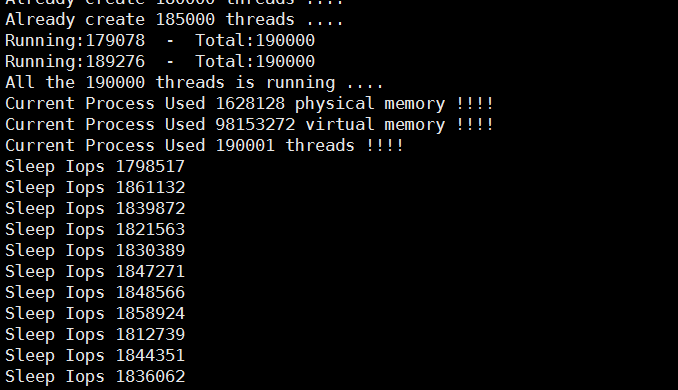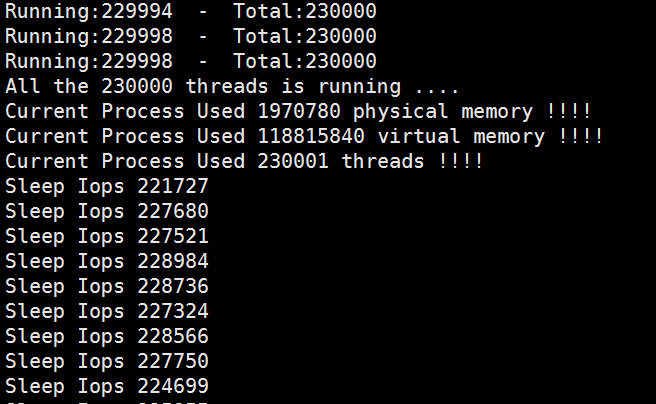Linux執行緒qps測試
阿新 • • 發佈:2019-01-10
本實驗源自該開源專案需求
https://github.com/yds086/HereticOS
實驗環境 OS : Centos 7.1 Kernel: 4.6.0 CPU : Intel(R) Xeon(R) CPU E5-2620 v2 @ 2.10GHz (開啟超執行緒) MEM : 48G DDR3 修改如下系統引數以建立儘量多的執行緒
/proc/sys/kernel/pid_max #作業系統執行緒數限制
/proc/sys/kernel/threads-max #作業系統執行緒數
max_user_process(ulimit -u)#系統限制某使用者下最多可以執行多少程序或執行緒
ulimit -s 512 #修改執行緒棧大小
/proc/sys/vm/max_map_count #單程序mmap的限制會影響當個程序可建立的執行緒數
/proc/sys/kernel/threads-max 這個值需要注意下:
4.6.0的核心中,該值:
threads = div64_u64((u64) totalram_pages * (u64) PAGE_SIZE,
(u64) THREAD_SIZE * 8UL);即48GB的記憶體,可以建立的threads-max為:
totalram_pages = 49432356KB/4KB = 12358089
threads = 12358089*4kB / (8kB * 8) = 772380
理論上可已得到應該是772380的執行緒數目,但不知為何,實際threads-max引數最多可以設定到772380/2 = 386190
虛擬碼
//任務模式 long long g_SleepIoCount=0; long long g_SleepIoLastCount=0; void IOTask() { for(;;) { Sleep(100);// 100 ms 1000ms 10000ms g_SleepIoCount++; } } void TestIo() { //建立一組併發任務 CreatTask(IOTask,1000000); //監測IO計數 for(;;) { Sleep(3000)//3s統計一次 printf("Sleep Iops %d",(g_SleepIoCount-g_SleepIoLastCount)/3); } }
測試程式碼
#define _GNU_SOURCE
#include <stdio.h>
#include <string.h>
#include <pthread.h>
#include <stdint.h>
#include <time.h>
#include <unistd.h>
#include <sys/syscall.h>
uint32_t g_sleep_ms = 0;
uint32_t g_threadcnt = 0;
uint32_t g_running_threadcnt = 0;
uint64_t g_SleepIoCount = 0;
int32_t g_main_bind = -1;
int32_t g_task_bind = -1;
#define USE_CORE_BIND 1
#define MSLEEP(x) usleep(1000 * (x))
#define ATOMIC_FETCH_AND_ADD(ptr,value) __sync_fetch_and_add((ptr), (value))
void *sleep_task(void* para)
{
if (g_task_bind >= 0)
{
cpu_set_t mask;
CPU_ZERO(&mask);
CPU_SET(g_task_bind, &mask);
if (pthread_setaffinity_np(pthread_self(), sizeof(mask), &mask) < 0)
{
printf("Bind to Core Error !\n");
return NULL;
}
}
ATOMIC_FETCH_AND_ADD(&g_running_threadcnt, 1);
while(1)
{
MSLEEP(g_sleep_ms);
ATOMIC_FETCH_AND_ADD(&g_SleepIoCount, 1);
}
}
static inline pid_t gettid(void){
return syscall(SYS_gettid);
}
void execute_cmd(const char *cmd, char *result)
{
char buf_ps[1024];
char ps[1024]={0};
FILE *ptr;
strcpy(ps, cmd);
if((ptr=popen(ps, "r"))!=NULL)
{
while(fgets(buf_ps, 1024, ptr)!=NULL)
{
strcat(result, buf_ps);
if(strlen(result)>1024)
break;
}
pclose(ptr);
ptr = NULL;
}
else
{
printf("popen %s error\n", ps);
}
}
void print_process_info(void)
{
char cmd_string[128] = {0};
char cmd_result[128] = {0};
pid_t my_pid = gettid();
memset(cmd_string, 0, sizeof(cmd_string));
memset(cmd_result, 0, sizeof(cmd_result));
sprintf(cmd_string, "cat /proc/%u/status | grep VmRSS | cut -d : -f 2 | tr -cd \"[0-9]\"", (uint32_t)my_pid);
execute_cmd(cmd_string, cmd_result);
printf("Current Process Used %s physical memory !!!!\n", cmd_result);
memset(cmd_string, 0, sizeof(cmd_string));
memset(cmd_result, 0, sizeof(cmd_result));
sprintf(cmd_string, "cat /proc/%u/status | grep VmSize | cut -d : -f 2 | tr -cd \"[0-9]\"", (uint32_t)my_pid);
execute_cmd(cmd_string, cmd_result);
printf("Current Process Used %s virtual memory !!!!\n", cmd_result);
memset(cmd_string, 0, sizeof(cmd_string));
memset(cmd_result, 0, sizeof(cmd_result));
sprintf(cmd_string, "cat /proc/%u/status | grep Threads | cut -d : -f 2 | tr -cd \"[0-9]\"", (uint32_t)my_pid);
execute_cmd(cmd_string, cmd_result);
printf("Current Process Used %s threads !!!!\n", cmd_result);
sleep(3);
return ;
}
void main(int argc, void* argv[])
{
if (argc != 5)
{
printf("Usage:$s thread_cnt sleep_ms main_bind task_bind \n", argv[0]);
return;
}
g_threadcnt = atoi(argv[1]);
g_sleep_ms = atoi(argv[2]);
g_main_bind = atoi(argv[3]);
g_task_bind = atoi(argv[4]);
if (g_main_bind >= 0)
{
cpu_set_t mask;
CPU_ZERO(&mask);
CPU_SET(1, &mask);
if (pthread_setaffinity_np(pthread_self(), sizeof(mask), &mask) < 0)
{
printf("Main Bind to Core Error !\n");
return;
}
}
int ret = 0;
uint32_t i;
pthread_t thread;
for (i = 0; i < g_threadcnt; i++)
{
if (i % 5000 == 0)
{
printf("Already create %d threads ....\n", i);
}
ret = pthread_create(&thread, NULL, &sleep_task, NULL);
if (0 != ret)
{
printf("[ERROR]Create thread error, index:%d, ret:%d!!!\n", i, ret);
return;
}
}
//waiting for thread all running
while (g_running_threadcnt != g_threadcnt)
{
printf("Running:%d - Total:%d \n", g_running_threadcnt, g_threadcnt);
sleep(1);
}
printf("All the %d threads is running ....\n", g_running_threadcnt);
print_process_info();
//excute the test
uint64_t last_cnt = 0;
int test_cnt = 0;
for (; test_cnt < 50; test_cnt++)
{
sleep(3);
if (test_cnt != 0)
printf("Sleep Iops %d \n",(g_SleepIoCount-last_cnt)/3);
last_cnt = g_SleepIoCount; // maybe not accurate ...
}
print_process_info();
return;
}
test:pthreadtest.c
gcc -g -O3 -o test ./pthreadtest.c -lpthread
clean:
rm -rf ./test
測試場景
單一核心上可以同時執行的最大執行緒數目
執行 ./test 325000 1000 1 2 , 即建立325000個執行緒,每個任務執行緒sleep 1s,同時主程序繫結在核心1上,任務執行緒均繫結在核心2上。
可以看出,主程序很快就建立完了325000個執行緒,但由於這些執行緒均繫結至核心2上,並且已經執行的執行緒只sleep 1s,導致需要執行的執行緒得不到時間片。 (用島主的話說:“那就是被io上限約束了吧, 再建立的都餓死,而不是都給點飯吃嗎”) 結論: 經過測試,本實驗環境下,在sleep 1s情況下,建立24w左右的執行緒可為極限。
單一程序進行核心繫結,得出單核的qps極限值
執行./test 26000 100 1 2
調整建立的執行緒數目,發現大於26000的執行緒後,建立執行緒將變的困難,和測試場景1屬於同樣的問題。 結論: 經過測試,本實驗環境下,在sleep 100ms情況下,單核qps極限值為25w左右,此時任務核心cpu跑滿100%
同樣的,時間擴大1倍至1s,執行緒數目擴大至250000,結果如下:(線性擴大至260000時,程式響應慢)

結論: 經過測試,本實驗環境下,在sleep 1000ms情況下,單核qps極限值為24w左右,此時任務核心cpu跑滿100%
我的環境下/proc/sys/kernel/threads-max最多30w左右(記憶體限制),導致無法測試10s的情況
同時執行多個程序,並進行核心繫結
同時執行./test 26000 100 1 2 和 ./test 26000 100 3 4

測試結果:多核心的cpu,在此種測試結果下,qps基本成線性增加,(同時在物理核和超執行緒核心,會有一定影響)
將執行執行緒和sleep時間同時擴大10倍,即同時執行./test 240000 1000 1 2 和 ./test 240000 1000 3 4: 測試結果如下
單一程序,不進行核心繫結
不進行核心繫結,由linux預設進行排程,理論上應該是25w * 12 的qps,在我的12核心cpu實驗環境下得到如下結果: 執行 ./test 190000 100 -1 -1
此時的cpu基本跑滿

如前述所說,和超執行緒也有一定的關係,所以並不一定是完全線性的。
測試結果:19w的執行緒,sleep 100ms,基本可以達到190w的qps,再進一步建立執行緒比較困難。
測試彙總
| 任務數 | sleep 100ms | sleep 1000ms |
| 26000 | 25w qps | |
| 250000 | 24w qps | |
| 180000 | 180w qps |
相關結論:
1)單個cpu核心的qps,可達25w qps;
2)多核心cpu,qps可擴充套件,基本符合線性,但超執行緒需關閉

